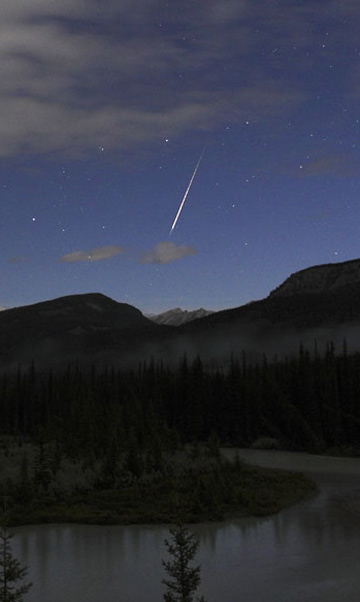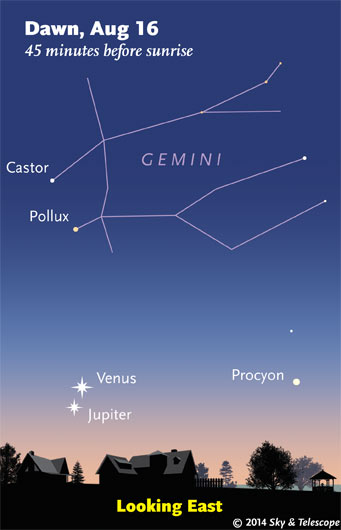
Friday, August 8
Already you may see an occasional Perseid meteor if you keep an eye on the night sky. The shower's peak night is predicted for next Tuesday (August 12–13), but moonlight will compromise the view all week.
Look northeast as the stars come out for W-shaped Cassiopeia. It's still not quite as high as the Big Dipper is in the northwest, but the two are on their way to their dusk balance point week by week. Get a preview of this by checking on them around 11 p.m. (depending on your location).
Saturday, August 9
If you're in the Earth's mid-northern latitudes, bright Vega passes close by your zenith around 10 or 11 p.m. (depending on where you live east-west in your time zone). Wherever you are, Deneb always passes the zenith two hours after Vega.
Sunday, August 10
Largest full Moon of the year, but not by much. Can you really detect any difference? The Moon is only 8% larger than average. See our article, The Not Very Supermoon.
Monday, August 11
Mars is pulling a little closer to Saturn every day. Spot them in the southwest at dusk; Mars is the one on the lower right. Tonight they're still 8° apart. Look farther to the lower right of Mars for twinkly Spica.
Tuesday, August 12
Peak Perseid meteor night late tonight. But the Moon, just two days after full, compromises the view. See our article, Perseids vs. Moonlight: Which Will Prevail?.
Wednesday, August 13
The waning gibbous Moon rises in the east just about at the end of twilight. Look above the Moon (or above where it's just about to rise) for the Great Square of Pegasus, larger than your fist at arm's length and standing on one corner.
Thursday, August 14
Vega is almost overhead after dark. The brightest star in the southeast is Altair, nearly as bright. Altair is flagged by little Tarazed (3rd magnitude) a finger-width above it: an orange giant far in Altair's background.

Friday, August 15
For the next several mornings, look low in the east-northeast about 45 to 30 minutes before sunrise for Venus and Jupiter very close together. On Saturday morning, these two brightest planets are still 1.8° apart. They'll be closest on Monday morning the 18th: just 0.2° apart at the time of dawn for Europe, 0.3° by the time dawn reaches the Americas.
Saturday, August 16
The two brightest stars of summer are Vega, overhead soon after dark, and Arcturus, shining in the west. Vega is a white-hot type-A star 25 light-years away. Arcturus is an orange-yellow-hot type-K giant 37 light-years distant. Their color difference is fairly clear to the unaided eye. Both are dozens of times more luminous than the Sun.
Want to become a better astronomer? Learn your way around the constellations. They're the key to locating everything fainter and deeper to hunt with binoculars or a telescope.
This is an outdoor nature hobby; for an easy-to-use constellation guide covering the whole evening sky, use the big monthly map in the center of each issue of Sky & Telescope, the essential guide to astronomy. Or download our free Getting Started in Astronomy booklet (which only has bimonthly maps).

Once you get a telescope, to put it to good use you'll need a detailed, large-scale sky atlas (set of charts). The standards are the little Pocket Sky Atlas, which shows stars to magnitude 7.6; the larger and deeper Sky Atlas 2000.0 (stars to magnitude 8.5); and once you know your way around, the even larger Uranometria 2000.0 (stars to magnitude 9.75). And read how to use sky charts with a telescope.
You'll also want a good deep-sky guidebook, such as Sue French's Deep-Sky Wonders collection (which includes its own charts), Sky Atlas 2000.0 Companion by Strong and Sinnott, the bigger Night Sky Observer's Guide by Kepple and Sanner, or the beloved if dated Burnham's Celestial Handbook.
Can a computerized telescope replace charts? Not for beginners, I don't think, and not on mounts and tripods that are less than top-quality mechanically (able to point with better than 0.2° repeatability, which means fairly heavy and expensive). As Terence Dickinson and Alan Dyer say in their Backyard Astronomer's Guide, "A full appreciation of the universe cannot come without developing the skills to find things in the sky and understanding how the sky works. This knowledge comes only by spending time under the stars with star maps in hand."
This Week's Planet Roundup
Mercury is out of sight in the glare of the Sun.
Venus (magnitude –3.8) and Jupiter (a sixth as bright at magnitude –1.8) shine close together low in the east-northeast during dawn. They're in conjunction on the morning of the 18th, just 0.2° or 0.3° apart.
Mars and Saturn, identically bright at magnitude +0.5, glow in the southwest at dusk. Mars is the lower one. Look to their left for the head of Scorpius, highlighted by Delta Scorpii, and then Mars-colored Antares.
The two planets are closing in on each other. They'll pass 3½° apart on August 23–26.
Uranus (magnitude 5.8 in Pisces) and Neptune (magnitude 7.8 in Aquarius) are well placed in the southern sky in the early-morning hours. Finder charts for Uranus and Neptune.
----------------------------------
All descriptions that relate to your horizon — including the words up, down, right, and left — are written for the world's mid-northern latitudes. Descriptions that also depend on longitude (mainly Moon positions) are for North America.
Eastern Daylight Time (EDT) is Universal Time (UT, UTC, or GMT) minus 4 hours.
 9
9
Comments
mary beth
August 11, 2014 at 12:58 am
The moon was bright and beautiful here in Houston/Seabrook Tx! Mars seemed redder than usual, my colorblind friend (who normally can't distinguish reds very well) even noticed the intensity. Very nice last moon of (meteorological) summer.
You must be logged in to post a comment.
David Dunn
August 11, 2014 at 3:38 am
I was able to compare a picture I took of April's eclipsing moon and tonight's moon and found indeed that tonight's moon was bigger indeed.
Reds do tend to stand out more in brighter skies. Did Antares and Arcturus look redder too?
You must be logged in to post a comment.
mary beth
August 11, 2014 at 11:48 am
Awesome!! Did you post your pictures here? Glad you had a clear sky!!
Antares did look more orange now that you mention it! I haven't been paying as much attention to it because I've been so focused on the planets! Mars does not have a rival in my heart lol! Arcturus always looks white to me, except in the Spring when it's lower and I'm looking at it through atmosphere.
Is your astronomy club going to try to watch the live landing of Philae on Comet 67P/C-G this November? The timing might be tricky though....
You must be logged in to post a comment.
David Dunn
August 12, 2014 at 3:34 am
I did try to submit my picture to this website. We'll see what happens. The lander will land on a Tuesday - I'm not sure if I'll have time that day to look at it 🙂
You must be logged in to post a comment.
mary beth
August 12, 2014 at 3:38 pm
Let me know if it posts. I assume it under the moon category. Did you ever post any other pics? I've looked but didn't see any of your submissions. Did you see Google's homepage today? Neat little meteor shower video and Google done up in stars! https://www.google.com/?gws_rd=ssl. Hope it's still on web by the time you read this :)!!
You must be logged in to post a comment.
David Dunn
August 12, 2014 at 6:03 pm
No, this is my first submission to S&T (and I did this under my email name, unfortunately). I usually post on our Club Facebook page. Yes, I saw the Google Doodle for the Perseid Meteor shower (and showing those amazing time lapse videos.)
Not sure if I will try tonight to look for meteor with the moon so bright....
You must be logged in to post a comment.
mary beth
August 12, 2014 at 8:34 pm
I hope you decide to watch.....my husband saw one from here in light polluted Houston about 4:30 am!! He just happened to see it! I'm planning on spending at least one hour outside between 1 and 5!! I think it's going to be clear...!!! Better make a run to the store for fun snacks and drinks :)!!
You must be logged in to post a comment.
David Dunn
August 13, 2014 at 4:19 am
Just spent 1/2 hour looking for Perseids and found about 7. Conditions were less than ideal: light pollution from city lights and moon and high clouds - but I saw a few.
You must be logged in to post a comment.
mary beth
August 14, 2014 at 12:17 am
At least you saw a few! I spent an hour looking and didn't see even one. It was still fun being outside late though. Now the next big thing is the Venus/Jupiter conjunction on the 18th. Sure is an exciting time of year, all the changes in nature and the earlier twilight! I've been trying to recall how much longer Spica will be visible.
You must be logged in to post a comment.
You must be logged in to post a comment.